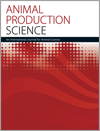Animal Production Science
Volume 62
Numbers 10 & 11 2022
Special Issue
AAAS Conference 2022
Guest Editors
Ed Charmley, lead Guest Editor (CSIRO)
Reza Barekatain (Government of South Australia)
Surinder Singh Chauhan (The University of Melbourne)
David Innes (University of Guelph)
Stephanie Muir (Agriculture Victoria)
Lucy Watt (CSIRO)
Cara Wilson (Central Queensland University)
ANv62n11tocTable of Contents
Nutrients exert control of physiological functions in animals through their ability to alter gene transcription by interacting with transcription regulators within cells (‘nutrigenomics’ effect). Molecular techniques have allowed the discovery of gene networks controlling nutrigenomics responses in livestock. Since nutrition, health, and performance interact continuously and respond to changes in environment and physiology of the animal, application of holistic approaches is central for uncovering key molecular players involved in the animal'sadaptations to changes in nutrient supply and environmental conditions.
In the Brigalow Belt bioregion of Australia, clearing native vegetation for agriculture since the 1960s has altered hydrology and nutrient cycling over 36.7 million hectares. Long-term monitoring at the Brigalow Catchment Study has quantified changes in hydrology and soil fertility as a result of land-use change. Agricultural systems established soon after clearing were initially highly productive; however, productivity has since declined in accordance with declines in soil fertility.
Empirical studies in extensive rangelands are needed to quantify relationships between short-term foraging behaviours (e.g. minutes to days) and longer-term measures of animal performance. We found that two daily measurements of foraging behaviour, mean grazing-bout duration and mean velocity while grazing (both calculated at a 5 min resolution), can explain 62% of the variation in weight gains of free-ranging yearling steers grazing semiarid rangeland.
Global challenges around sustainability are putting different pressures on the welfare of livestock. This paper highlights ‘win–win’ improvements for both animal welfare and other aspects of sustainability, but even in these win–win situations, the adoption of improved practices is not a guarantee for a myriad of external factors. By having a better understanding of the system in which animals are raised, a broader understanding of an animal’s welfare, and acknowledging the emotional states that animals experience, progress towards improving welfare and, ultimately, addressing some of these global challenges, can be made.
With advances in sequencing technology, research of microbial communities has become more accessible and affordable. In livestock research, the roles of microbiota are associated with animal performance and welfare. Although universally accepted, amplicon-sequencing methodology has several issues that need to be considered in data interpretation. Here we review the main shortfalls, benefits and uses of the methodology in livestock research.
Sows are driven to build a nest before giving birth and require appropriate materials to do this. The advantage of allowing sows to nest-build is increased piglet survival; however, some materials cause blocked drains on the farm. Straw may be the best nesting material, but sows will also consume straw increasing dietary fibre intake. To limit drainage issues, alternatives to straw in combination with high-fibre diets should be explored for sows to improve welfare and piglet survival.
Producers’ behaviour towards animal welfare emerges from a complex interplay of factors including personal attitudes, social norms, and the broader societal context. Applying a behavioural science lens can further enrich our understanding of these factors and develop strategies for how animal welfare can be improved. This project represents a potential step-change in agriculture by applying behavioural science to improve producer communications relating to animal welfare.
To remain viable, livestock businesses need to build resilience to climatic and market variability by regularly producing a profit. The farm-management economics framework was used to conduct a contemporary assessment of livestock enterprises in the semiarid rangelands of Queensland. Existing small ruminant enterprises were profitable and resilient alternatives, based on contemporary prices. However, when changing from the predominant beef cattle enterprise, and incurring significant capital costs to do so, financial risk was substantially increased, which has implications for property managers.
Environmental stress and poor nutrition of pregnant cows are main factors responsible for high mortality of calves. The mechanism explaining why have not been described and most effort has been applied to increase body condition of the cow around calving, which is frequently not achievable in the dry tropics. This study identified a hormonal mechanism explaining how improving diet quality may increase milk delivery to neonates, opening new possibilities for short-term strategies to reduce calf mortality and improve calf health.
Reproductive efficiency is a performance indicator in extensive beef systems. Calving represents a critical management period that would benefit from increased observational capacity. Precision livestock technologies offer opportunities to better monitor and manage extensively grazed cattle, but more algorithms are needed to detect behaviours and physiological changes. This study used a commercial on-animal sensor to evaluate the value of global navigation satellite system-derived features in parturition detection algorithms. Results indicated both social interaction and spatial utilisation features are good candidates for algorithm development.
Virtual fencing technology has the potential to be used for intensive grazing systems, while reducing the labour involved with these systems. This study compared utilisation and grazing pressure at the fence line between virtually fenced and electrically fenced sheep, using an intensive grazing method. Pasture consumption was similar between the two groups, indicating that the use of virtual fencing does not affect grazing behaviour in sheep. Further work should be conducted in larger flocks and by using automated systems.
There are many different equations to estimate metabolisable energy content of ruminant feeds by different international feeding systems. This study compared 24 equations to predict metabolisable energy content of forage sorghum. There were differences between equations based on whether metabolisable energy content was predicted from digestibility or chemical composition. As such, applying these different equations will markedly affect ration formulations.
Heat-shock protein 70 (HSP70) levels in body fluids have been measured to assess heat stress in many animal species. The HSP70 is yet to be detected in cow’s milk and this study optimised a sensitive enzyme immunoassay (ELISA) to quantify HSP70 in cow’s milk. The HSP70 masses were higher in cow's milk samples taken during hot weather and collected from high-yielding animals. The assay of HSP70 in milk would be a useful tool for non-invasive detection of heat stress.
High prices for goats in Australia due to high international demand has resulted in a transition from opportunistic harvesting to more managed production systems for Rangeland goats. There is limited information available to establish feeding strategies to maximise growth rates of goats within these managed production systems. The present paper demonstrates that the highest rates of liveweight gain of young male Rangeland goats is when they are offered a high energy supplement.
Steers on a low-protein diet showed bacterial modification correlated to feed efficiency, whereas bacterial growth in the most efficient steers relied on the animal’s capacity to recycle nitrogen as a response of low dietary ammonia content. These outcomes may facilitate the selection of highly feed efficient cattle fed a low-protein diet.
Intertidal estuarine environments expose oysters to extreme environmental temperatures. This can increase microbial pathogens in oysters, making them more susceptible to diseases. The study looked at the microbes in Pacific oysters and how they changed in a viral infection, at different seawater temperatures. Increased seawater temperature was associated with pathogenic microbes and a higher susceptibility to disease, indicating its role as a key risk factor in oyster health.





